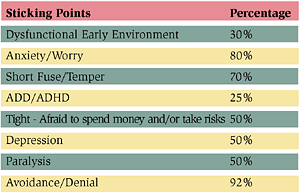The Psychology of Stuck: When Your Business Isn’t Improving
Sometimes the symptoms of a real business problem can be tough to find. Here are some typical examples:
- Harry is a contractor who has struggled over recent years but has improved his business through better marketing and watching his numbers. However, he cannot retain good help because he does not pay enough. Turnover is high and morale is bad. Isn’t everyone’s? Down deep, he knows he needs to pay more but does not believe there are people out in his market that are worth it. Harry feels stuck.
- John does $1.2 million per year in business and is very good at keeping his guys busy. Unfortunately, he does not build enough time into his estimates. As a result, the business is always strapped for cash and the largest yearly salary (including profit) John has ever taken home is $48,000. He knows he bids low but he does it to keep up the volume. He works 60 hours per week and has not had a vacation in four years. John is stuck.
- Sam has had an established business in a small community for the past 12 years doing about $800,000 per year based on referrals and the yellow pages. For the past 8 months, business has been losing money to the tune of $1,100 per month. The reason: Two new competitors have been whittling away his market share. Cash reserves are about gone. Sam refuses to change his way of doing things. Sam has come down with a fatal strain of “stuck.”
All of these business problems seem like simple issues but for some reason the people involved refuse to change. These contractors seem to be stuck and refuse to make what are obvious decisions to other business owners. Dan and I have coached and consulted a multitude of business owners. In almost all cases, we have found that there is a period where the business reaches a plateau or becomes “stuck.” It can last for just a short period of time or the entire life of the business. Frequently, as a business consultant, I can give people obvious advice. But if they are not willing to make the necessary changes, it can really be tough to help. When coaching younger consultants, I have always told them that the real issue is not figuring what the customer should do but rather to determine what the client will do.
With this in mind, I asked business coach Dan Kohler, to go through his files and determine from his dozens of clients what gets in the way of making decisions.

Anxiety and Avoidance
I, Dan Kohler, found this to be an interesting project. While such an approach was not scientific and will not make the Harvard Medical Journal, it did provide some realistic data and information that can help business owners make better decisions. I went file by file, and on a piece of paper tracked the business owners I coached and what their issues were when making decisions. The results were as follows:Obviously, the sum of these issues does not add up to 100 percent because some of the people that I studied had more than one problem. Some of these issues are very difficult to correct and we would never attempt to do so in an article. A dysfunctional early environment (child abuse, alcoholic parents, overweight child and social stigma, etc.) and difficulties such as ADD/ADHD (Attention Deficit Disorder and Attention Deficit Hyperactivity Disorder) are best treated in a clinical environment.
The real issues that jump off the chart are anxiety and worry, plaguing 80 percent, or four out of five owners and managers, with denial and avoidance of critical issues coming in at 92 percent of the people I coach. This really surprised me. Let’s focus on the two main issues: anxiety and avoidance.
To avoid complicated terminology let’s keep definitions simple. Let’s describe anxiety as excessive worry and avoidance. Let's describe denial as a routine avoidance of issues that becomes so second nature that the issues are forgotten but the need for a decision remains, creating a “decision gap.” (Due to the nature of denial, you are not necessarily aware of the decision gap, but you will feel the stress that the gap creates.) Finally, let’s describe a sticking point as an issue that is getting in the way of the owner or manager making a decision.
The Bottom Line
Statistically, anxiety and avoidance were the most common and significant. What this says is that 80 to 90 percent of owners and managers worry far too much about an issue (anxiety, 80 percent) that runs them in circles. As a result, they avoid (92 percent) making decisions about that issue. After a while, the avoidance becomes second nature and the problem is now routinely ignored, but the issue has not gone away. Now we have denial. Therefore stuck means not making crucial decisions, for one reason or another, and/or following through with them.So why would business owners and managers be stuck in this cycle more than others would? Well, the buck stops with you. If you are an employee, the boss forces you to make a decision. When you are the boss, you have no such direction. The further up the chain of command you go the more important it is to make decisions. Your leadership and your leadership alone drive this situation.
OK, all of this sounds pretty touchy-feely and complicated, but let’s make it real. Ever had an employee whose behavior got worse and you avoided talking to them? Ever had a customer who owed you money and you were reluctant to call? Ever had a bad month and you put off looking at the month’s statement because you knew it was going to be ugly? Sure, all of us have done this. So when does such avoidance become an issue? Simple, when the decision is major and you avoid making the obvious changes.
Some Suggestions
At PROOF Management, we see businesses enter plunder each and every day: Owners who fail to make decisions they need to make. Maybe a founder who rests on the business laurels a little too long. Maybe a business where employees are leaving because the business fails to adjust to market conditions. Maybe a contractor and the stresses have gradually become so great it is difficult to make a decision.
So how do you deal with these issues and make the tough decisions?
1. Face the issue. The longer you wait, the bigger the problem becomes. Denial just ups the ante at the end. For example, the parent who fails to correct and discipline the child at eight and 15, visits the son or daughter in prison at 18. Ever notice that the employee you fired never keeps you awake at night?
2. Start making decisions and taking control of the situation. Start with little decisions but start making them. We hear business owners every day complain about employees and customers. Such behavior just makes things worse and creates bigger issues.
3. Seek balance and outside advice. If you cannot seem to make this change by yourself seek counsel. This could be merely another business owner that advises you and helps you through the situation.
In summary, do not let your business go down the drain. If you worry and go around and around without changing, you may end up worse than merely circling but rather at the bottom of the drain looking up. Even if your business is making money now, getting too comfortable and failing to make these decisions will get you. Business is not easy; if it were, everyone would be in it. Face the issues, start making some decisions and seek some balance. Life is too short and next year will come quicker than you think.
Looking for a reprint of this article?
From high-res PDFs to custom plaques, order your copy today!





